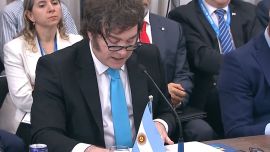Most recent global data indicates that the number of cases and deaths caused by the disease will grow in Latin America in a faster pace than the average.
Different sectors point to the need of action in order to increase access to cancer treatment. Better infrastructure, more financing, human resources and availability of treatment are the most mentioned solutions.
Every two minutes, five persons are diagnosed with cancer in Latin America. The region has 1.4 million new cases per year and the disease continues to increase. In September 2018, the International Agency for Research on Cancer (IARC), linked to the World Health Organization (WHO), updated the Global Cancer Observatory and the picture for the future is alarming: the incidence of the disease is bound to grow 63 percent in the world until 2040, and the number of deaths should increase 71.5 percent.
In developing areas, like Latin America, where early diagnoses and access to treatment are more difficult, the outlook is even worse: the number of cases must leap 73% in the next 21 years, getting close to 2.5 million a year.
At the same time, access to healthcare in the region faces serious problems: according to a study published in The Lancet, more than 156 million people die every year due to the lack of access to health services. The growing need of attention faces fragmented health systems, lacking infrastructure, human resources, diagnostic, treatment and financing.
In Argentina, the IARC estimates that new cases of the disease will increase by 47.8 percent until 2040, leaping from the current 129,047 to 190,779. Deaths are due to pass from the current 69,000 to 105,000 a year, a growth of 53.9 percent. Breast cancer is the main type both in incidence and in deaths, according to data of the National Cancer Institute (INC). This kind represents 17 percent of all cases and almost a third of women’s cancer.
IMMEDIATE INTERVENTIONS
The progression of the disease calls for immediate intervention in order to overcome the health system’s fragmentation, which affects access to medical professionals. Argentina’s Constitution determines that the state must provide 100 percent of healthcare for cancer patients, but the country’s regulatory agencies still haven’t established the guidelines of how this should work. The country has seven public health care sub-systems and around 20 percent of the population have double cover, variables that – according to Eduardo Cazap, one of the most important specialists in cancer of the region– make the mission of universalising healthcare to the population even more complex.
The situation could improve in the next few years, as the country formulates its National Control Cancer Plan, which consists of many strategies to tackle the disease. Nowadays, there are isolated plans for some kind of tumours, such as breast and cervical cancer, and others like inherited tumours and palliative care, which must be integrated into a single system.
Cazap believes that the creation of the plan is a sign of significant progress, but it will not be sufficient, he warns, unless it is adapted to the country’s reality. “In order to be effective, the plan must be well designed, adapted to the country’s needs and fit with existing resources,” he says.
REGIONAL THEMES
Argentina faces problems that are common to other Latin-American countries: little investment in prevention, difficulties in getting an early diagnosis and in getting primary care to the patient.
“One of our great difficulties is the response capacity in the first levels of healthcare, the lack of general practitioners or family doctors,” says the director of Universidad Isalud, Ruben Torres.
Cazap also complements that by saying that prevention does not receive the necessary attention from the national administration.
“Prevention programmes are essential in order to take care of our population’s health. But, unfortunately, most efforts are focused on diagnosis and treatment. It is a flaw in the systems, because politicians seek short-term results, and the results that come from prevention measures are only going to be seen in many years,” Cazap, the founder and first president of the LatinAmerican and Caribbean Society of Medical Oncology (SLACOM), said.
The difficulty in Argentina of getting a mammogram — the main method used to detect a breast tumour at an early stage — is an example of the difficulty in prevention. According to data from the Latin America Cancer Control Scorecard (LACCS), published by The Economist Intelligence Unit, the exam’s coverage reaches only 46 percent of all Argentinian women. That rate is more than the one in Mexico, for example, where only 22 percent of women take that exam, but it is still far from the recommended by the World Health Organisation (WHO). According to the international agency, in order to be effective, such programmes must reach at least 70 percent of the population.
related news
by BY ANA PAULA PEDROSA*























Comments